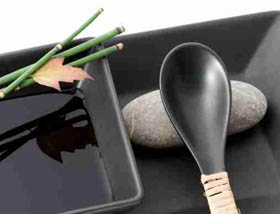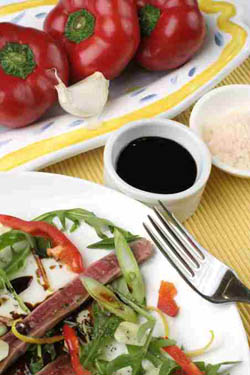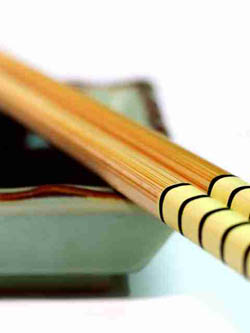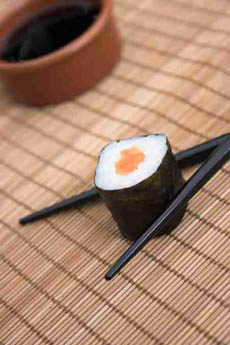When most people talk about black gold, they’re referring to oil. We think of a different dark liquid, one that is rich and salty and enhances our food. A good soy sauce adds a rich flavor in addition to saltiness, and for that reason can have a life far beyond Asian dishes. We use it in marinades, poaching liquids, and basting sauces; and as a general addition to the spice cabinet. Broccoli? Eh. Broccoli sauteed with a bit of olive oil and soy sauce? Now we’re cooking with gas!
When we got the idea to explore the world of soy sauce, we asked everyone we knew whether or not they had some in their home. Nearly everyone, from those with well-stocked family kitchens to the bachelor with an otherwise desolate fridge, owned at least one bottle of soy sauce.
When we asked a few more questions, we realized that while everyone (including all of use here at THE NIBBLE) owns at least one bottle of soy sauce, generally Kikkoman or Yamasa, quality brands used in most sushi bars. But it isn’t being used as often as it should. Many people—not savvy Asian-Americans, of course—admitted that their bottle had been sitting around (more on the debate over the best way to store soy sauce later) for over a year. In a few cases, we found that people who had been been using the same bottle of soy sauce since the ’90s. Kind of scary, no?
Why are foodies, who are always looking for new flavor combinations, ignoring soy sauce? Why was it not getting more play in fusion dishes? The soy sauces most of us are familiar with are assertive and mighty salty, so perhaps they didn’t invite thinking outside the box. But what if there were other soy sauces out there, boutique or gourmet soy sauces, that could be used for much more? With the right soy sauce, could we dress salads, enrich gravies and dips, even take a few sips? The possibilities were dizzying, and we had to get to the bottom of it.
To go right to the reviews, click here.
Soy Sauce Basics
To start, we looked at the components of soy sauce.
- Soy sauce is a fermentation of soybeans, grain (usually wheat), water and salt. It is typically dark brown (though colors can vary greatly) and has a pleasant, earthy smell. The differences among soy sauces usually come from the varying proportions of soy beans to wheat, as well as added ingredients.
- Tamari is a Japanese variation of soy sauce made for cooking, rather than for use a condiment. It contains more soybeans and little or no wheat. It retains more flavors in cooking than soy sauce; and its rich, meaty flavor crosses over well in Western gravies, soups and sauces.
Nearly every country that uses soy sauce as a staple makes it in a different way. The range is from a thick, black syrup reminiscent of molasses to a golden, clear “white soy sauce.” The sauces can be puckeringly salty, lightly salty, or cloying. Even in America, producers of soy sauce add their spin in an attempt to please domestic palates.
The soy sauces that we buy most often are Japanese, and are typically made in the style called shoyu. The prevalence of wheat as an ingredient in Japanese soy sauces makes them much sweeter than those from China and less salty than those from Indonesia.
Chinese soy sauces tend to be very high in soy beans and low in wheat. They are usually thicker than the Japanese brands that most consumers in the U.S. are accustomed to (quality Chinese soy sauces bear no relation to the thin, sickly sauce in packets from Chinese restaurants), though our favorite soy sauce from a Chinese manufacturer tasted more like a Japanese soy sauce.
|
 |
The Super Sauces
We sampled dozens and dozens of soy sauces, and these were our favorites. Some were very traditional, while others barely resembled the soy sauces of our acquaintance. All brought unique flavors to the table.
San-J
- San-J makes two kinds of Japanese-style organic tamari: one contains a small amount of wheat and the other is wheat-free. We preferred the Organic Tamari Wheat-Free Soy Sauce: it has a smooth, rich finish that its wheat-containing counterpart lacks. The strong flavor of this tamari makes it an excellent marinade for meats and hearty fish steaks, and a great enhancer for soups and stocks.
Eden Organic
- The Imported Tamari has a rich, fermented, molasses-like taste that compliments green vegetables. It retains its flavor in stir-frys and is a great marinade for tuna steaks. We also thought that the Imported Shoyu is great: it is lighter in color and flavor and has a saltier bite than the tamari, and is a perfect accompaniment to sushi and sashimi. Eden Organic also has a domestic tamari and shoyu, but we feel that the saltiness of both is suited only to serious sodium-lovers.
Lee Kum Kee
- Three of Lee Kum Kee’s Authentic Chinese soy sauce varieties make our top list. It is important to note that all three contain sugar, which gives them a sweeter taste that balances against the salt and sets them apart from other soy sauces. Their Premium Dark Soy Sauce, the thickest and darkest of all the soy sauces in our tasting, not only lends hearty flavor to meat, fish and poultry dishes; but a few drops drizzled across a finished dish creates a highly dramatic appearance. Lee Kum Kee’s Premium Soy Sauce also works well as an all-purpose sauce. We like it with sushi as much as with steamed vegetables; and it makes a great dipping sauce for cold soba noodles. The Lite Soy Sauce, which contains 50% less sodium than the Premium Soy Sauce, is just as tasty and can be used in all the same ways. It’s a great product for people who don’t tolerate salt well.
|
 Soy sauce mixed with rice wine vinegar makes a Soy sauce mixed with rice wine vinegar makes a
delicious, low-calorie vinaigrette.
|
Tabasco®
- Both as simple and as good as it sounds, Tabasco® has created a blend of soy sauce and their classic hot pepper sauce. We love it! It’s great on everything from scrambled eggs to meatloaf, and deserves a permanent place on the condiment table at barbeques. It adds seasoning and spiciness to burgers, chicken wings and even potato salad. Like the rest of us, you’ll ask yourself why you didn’t think of this combination a long time ago.
White Soy Sauce
- Their Golden White Tamari is one of the most interesting soy sauces we sampled. It gets its white (actually, golden) color from the fact that it is mostly wheat, as opposed to mostly soy. It has a slightly sweet taste, with notes of honey, and we think that it might the best dipping sauce for sushi and tofu. We even sprinkled a little over a fruit salad made of watermelon, melon and pineapple, and the mild saltiness brought out the best in the fruits. Its delicate flavors make it a great dipping and finishing sauce, though we feel that they got a bit lost in cooking. We were not previously familiar with white soy sauce, and we are highly impressed.
Pacific Island Specialties
- Original American Soy Sauce contains 50% less sodium than most of the other soy sauces that we sampled, but it doesn’t sacrifice an iota of flavor. In fact, we found ourselves sipping this soy sauce as one might sip a digestif—something that the salt content of even the mildest and most delicious tamari made difficult. The sauce is based on the family recipe of Guam-born
Teodoro Cruz. Cruz has created a soy sauce unlike any other. Like tamari, it contains no wheat; but it has a much lighter flavor and a sharp bite from ingredients like white vinegar, lemon and jalapeños. Its finish is refreshing, and the fact that it could be used straight as a diet salad dressing and vegetable dip (like balsamic vinegar can be used without oil) might come from another unusual ingredient: green onions. This was the most versatile of all the soy sauces: it was just as good in cooking as it was as a dipping sauce. It is the one bottle our editorial director took home for herself!
How We Used The Soy Sauces
After lots of experimenting, we found:
- In general, the flavor-forward tamaris were best for cooking. They enhance the flavors of meat, chicken and fish, and they kick up gravies, soups, and stocks.
- As a condiment, tamaris are great for sprinkling over caramelized onions, roasted potatoes and stir-fried greens.
-
 Shoyu, the Japanese soy sauces, works best as a dipping sauce with a sushi or tofu, as some of its flavors can be lost during high-heat cooking. Shoyu, the Japanese soy sauces, works best as a dipping sauce with a sushi or tofu, as some of its flavors can be lost during high-heat cooking.
- The Chinese soy sauces were the most all-purpose, working well both in the kitchen and at the table.
- The two more unusual soy sauces that we sampled, White Soy Sauce’s Golden White Tamari and Pacific Island Specialties’ Original American Soy Sauce, worked surprisingly well both in Asian dishes and in the most common American dishes, like hamburgers and steaks. We think of the Golden White Tamari as a delicate extra virgin olive oil—something that is meant to be savored and enjoyed with your best dishes—while Pacific Island Specialties’ Original American Soy Sauce is more like a regular olive oil, something that you could use on the dishes that you prepare each and everyday.
In general, opened bottles of soy sauce should be stored in the refrigerator, as the fermented alcohols in it can break down and cause a loss of flavor. Most people are unaware of this and store soy sauce on their shelf or in the pantry—which is fine if it is consumed relatively quickly, and not good if you still have that bottle on the shelf a year later. If you keep it out of the refrigerator, store it away from direct sunlight, as you would any oil or vinegar.
We hope that we’ve inspired you not only to take your soy sauce off the [refrigerator] shelf and put it to good use, but to also try some of these wonderful “gourmet” soy sauces and see for yourself the difference that the right soy sauce can make in your cooking.
|







 Shoyu, the Japanese soy sauces, works best as a dipping sauce with a sushi or tofu, as some of its flavors can be lost during high-heat cooking.
Shoyu, the Japanese soy sauces, works best as a dipping sauce with a sushi or tofu, as some of its flavors can be lost during high-heat cooking.













